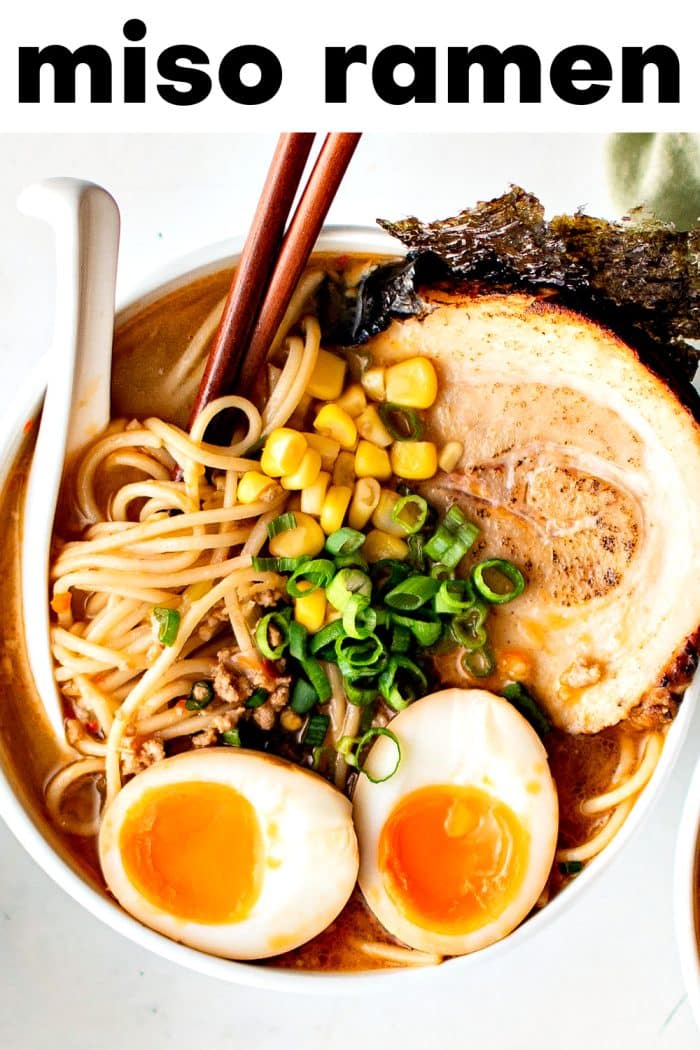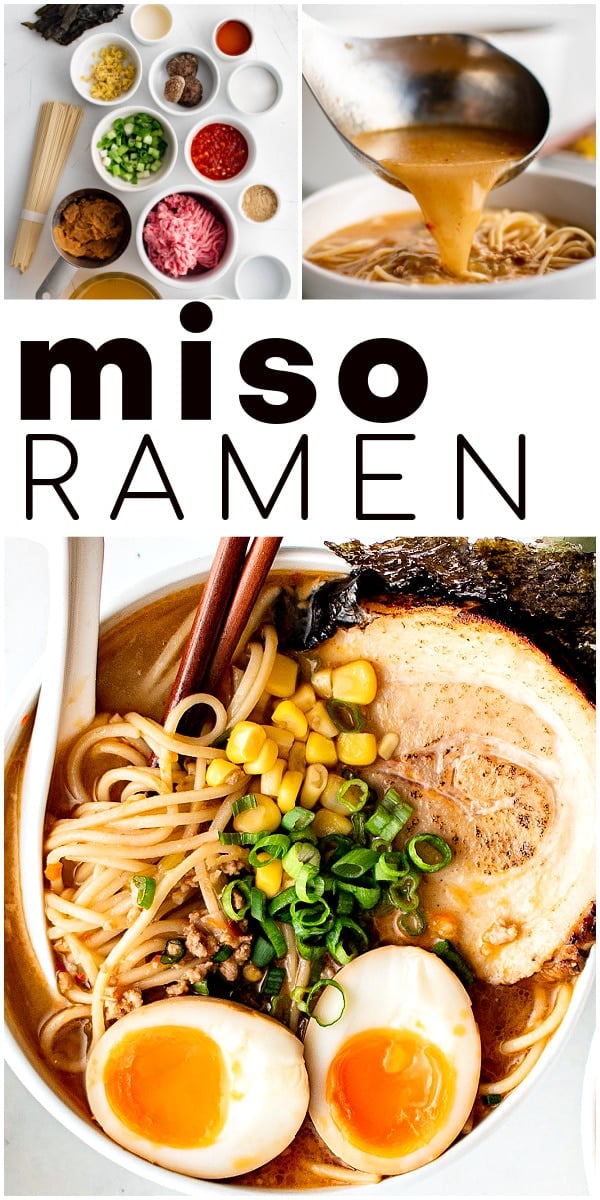This post may contain affiliate links. Please read our disclosure policy.
Flavored with umami-rich ground pork and chicken broth, this Spicy Miso Ramen features a mix of flavorful toppings, including ramen eggs, chashu pork, sweet corn, and green onions. Comforting, colorful, and so easy to make at home in just 45 minutes!
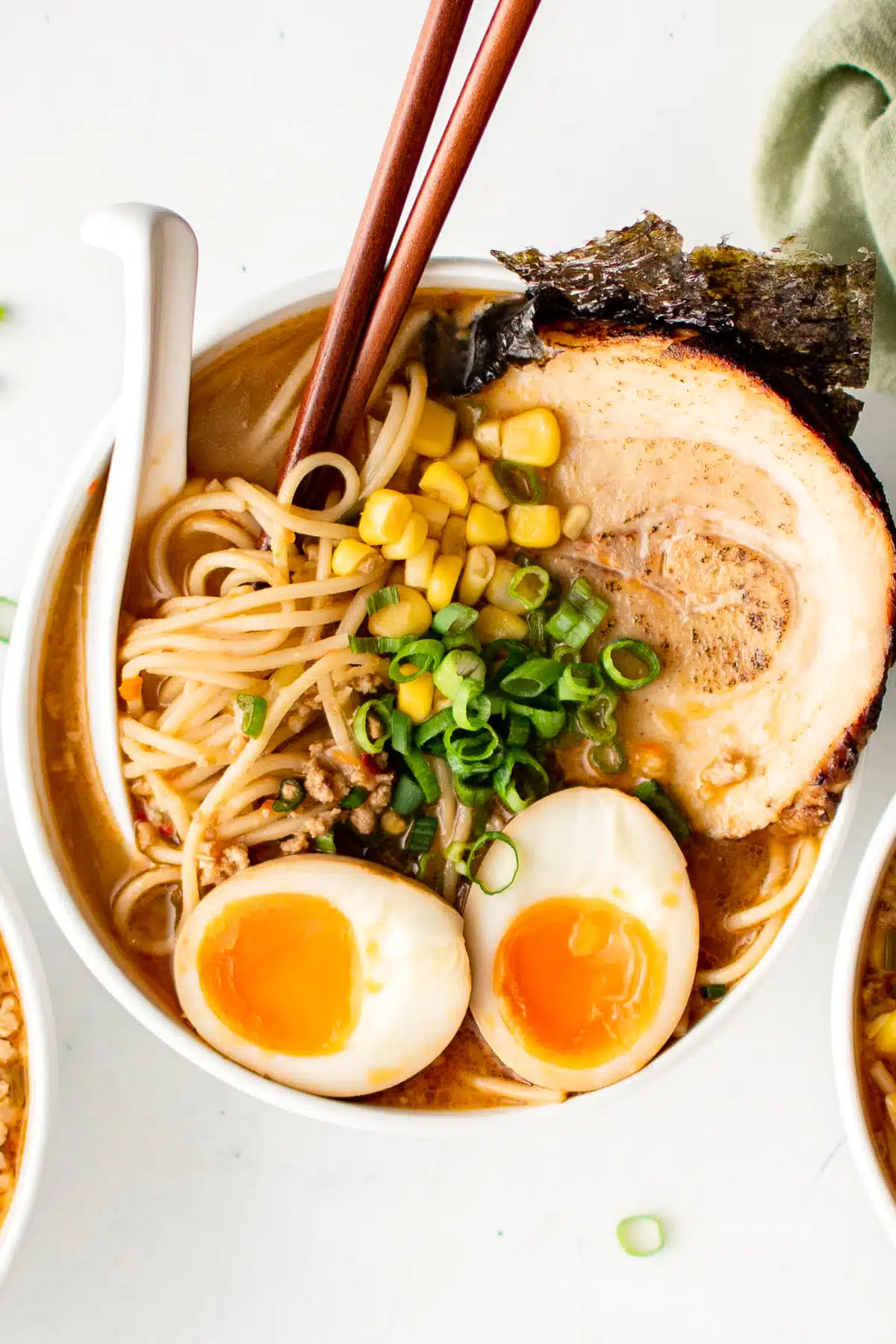
From vegetarian kimchi ramen to beefy birria ramen, nothing quite compares to a pipping hot bowl of ramen soup. This homemade miso ramen is my favorite of all.
What is Miso Ramen?
Miso (味噌) ramen is a popular Japanese noodle soup that was developed in Sapporo, Hokkaido. Thick, nutty, and slightly sweet in taste, miso ramen broth combines miso paste with chicken, fish, or tonkotsu (pork) broth and is often topped with a variety of flavorful toppings such as sweet corn, leeks, bean sprouts, ground pork, sesame seeds, and onions.
Ingredients for Miso Ramen
Here’s a breakdown of the most important ingredients needed to make miso ramen:
- Miso Paste: Arguably the most important part of miso ramen broth. Miso paste is a fermented mixture of soybeans, barley, rice, or other grains with a type of mold known as koji. The result is a thick, rich paste with a savory, salty, slightly sweet flavor. It’s used in many traditional Japanese dishes, and there are several types, each with its unique taste. White miso paste and red miso paste are the most widely available types available here in the States. For this recipe, I used red miso.
- Doubanjiang (豆板醤): Also known as “broad bean paste,” “fermented bean paste,” or “spicy bean paste,” doubanjiang is made from fermented broad beans, soybeans, salt, rice, and various spices. The paste has a deep, rich flavor that’s simultaneously salty, savory, and spicy. If you can’t find doubanjiang, substitute it with chili garlic paste such as Gochujang.
- Kombu: Although kombu is not required, it does add amazing umami flavor. This is especially valuable since we’re making this ramen using store-bought chicken broth. Read more about kombu in the section below.
- Broth: Along with miso paste, the broth usually includes chicken or pork stock for extra depth of flavor.
- Ramen Noodles: Ramen noodles are wheat-based noodles that are slightly elastic in texture. They come in various thicknesses and can be served straight or wavy. This ramen soup is delicious with both dried ramen noodles and fresh ramen noodles; however, fresh ramen noodles are always my top pick.
- Toppings: Common toppings for miso ramen include slices of braised pork (chashu), green onions, bean sprouts, corn, boiled eggs (often marinated), nori (seaweed), and sometimes even a pat of butter. The choice and combination of toppings can vary based on personal preference or regional style.
- Spices/Seasonings: These can include chili oil or sesame oil, garlic, and white pepper.
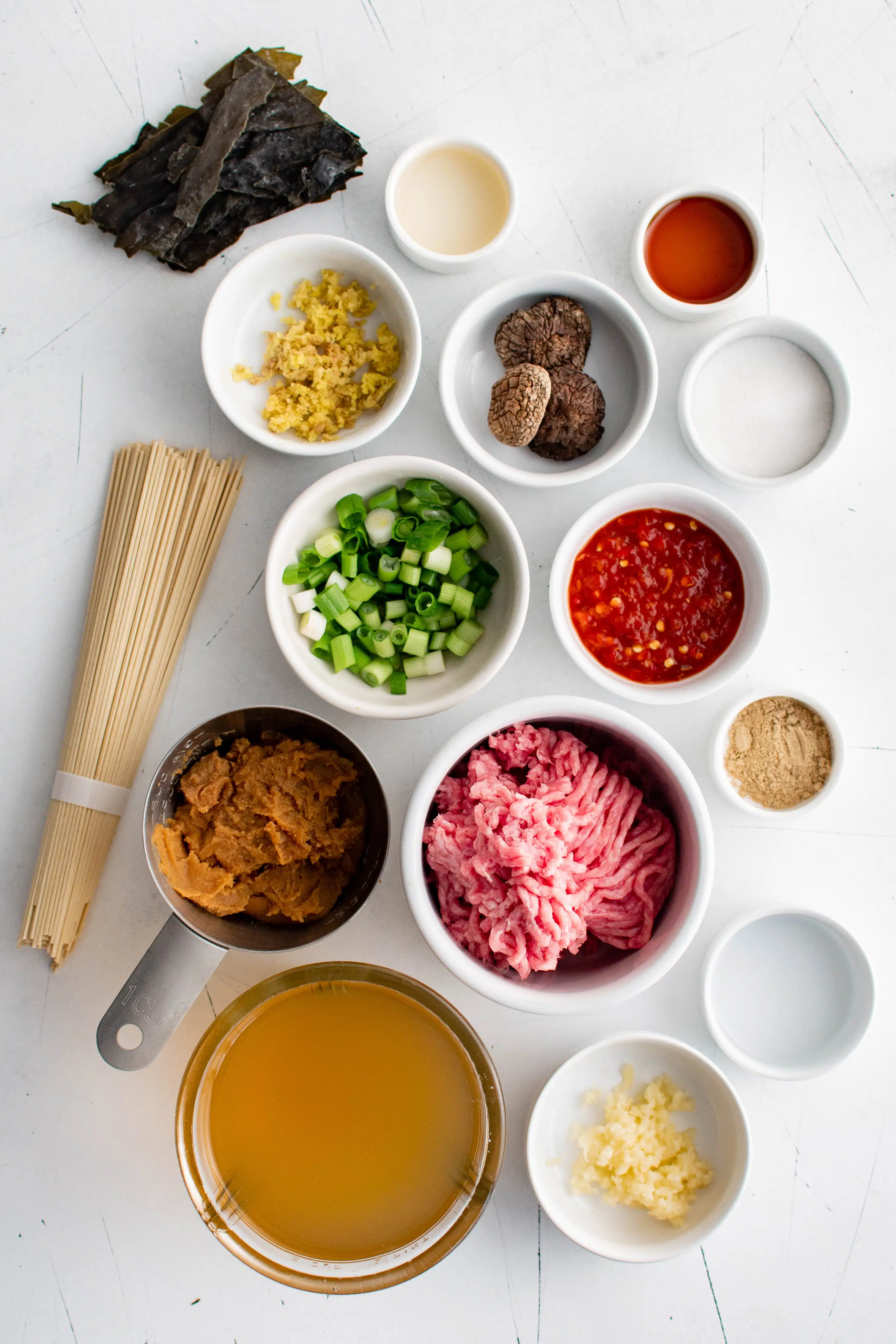
What is Kombu?
Kombu is a type of kelp, a large brown seaweed that grows in cold ocean waters. It’s commonly found in the waters around Japan, Korea, and China, and it plays a significant role in East Asian cuisine.
In Japanese cuisine, kombu is used in making dashi, a soup stock that forms the basis of many dishes, including miso soup and various noodle broths. The kombu is typically soaked in water and then gently heated to extract its flavor. Afterward, it’s often removed and discarded, although it can also be eaten or used in other dishes.
Kombu is rich in umami flavor due to its high content of glutamic acid, an amino acid that contributes to the savory taste. It’s also packed with various nutrients, including iodine, potassium, magnesium, and even some vitamins.
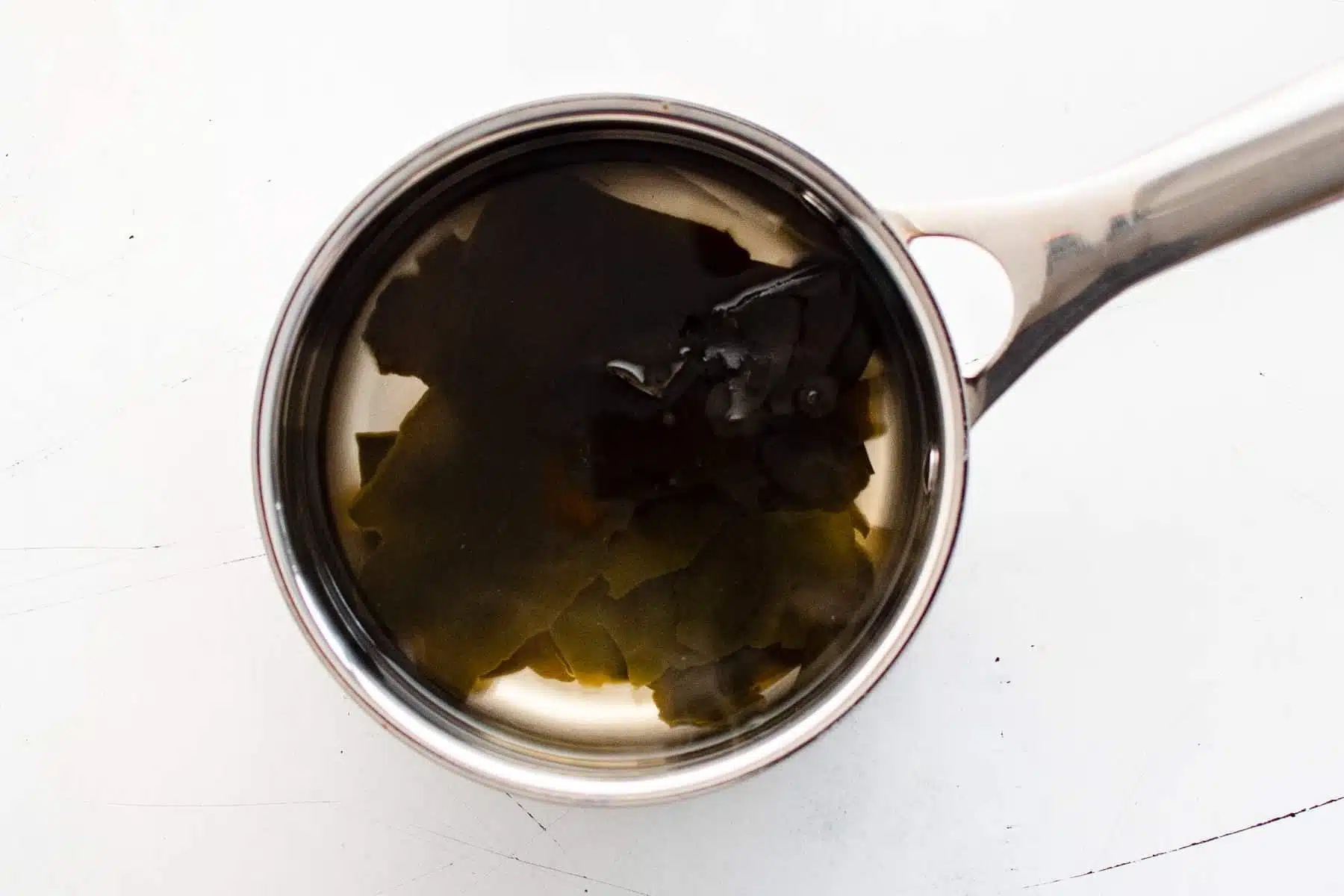
How to Make Miso Ramen
1. Soak the kombu: In a small saucepan, boil 2 cups of water, then remove from heat and add the sheets of kombu. Allow the kombu to sit for at least 10 minutes (or up to one hour) before removing and discarding the kombu.
2. Brown the pork: Heat a separate large Dutch oven or pot over medium-high heat. Add the sesame oil and ground pork to the pork and cook until browned – about 5-7 minutes.
3. Add the aromatics: Add the garlic and ginger and cook for 30 seconds until fragrant. Then add the green onions and shiitake mushrooms and cook for 2 minutes.
4. Add the miso paste, spicy bean paste (doubanjiang), sugar, and white pepper: Mix well to combine with the ground pork and cook for 1-2 minutes.

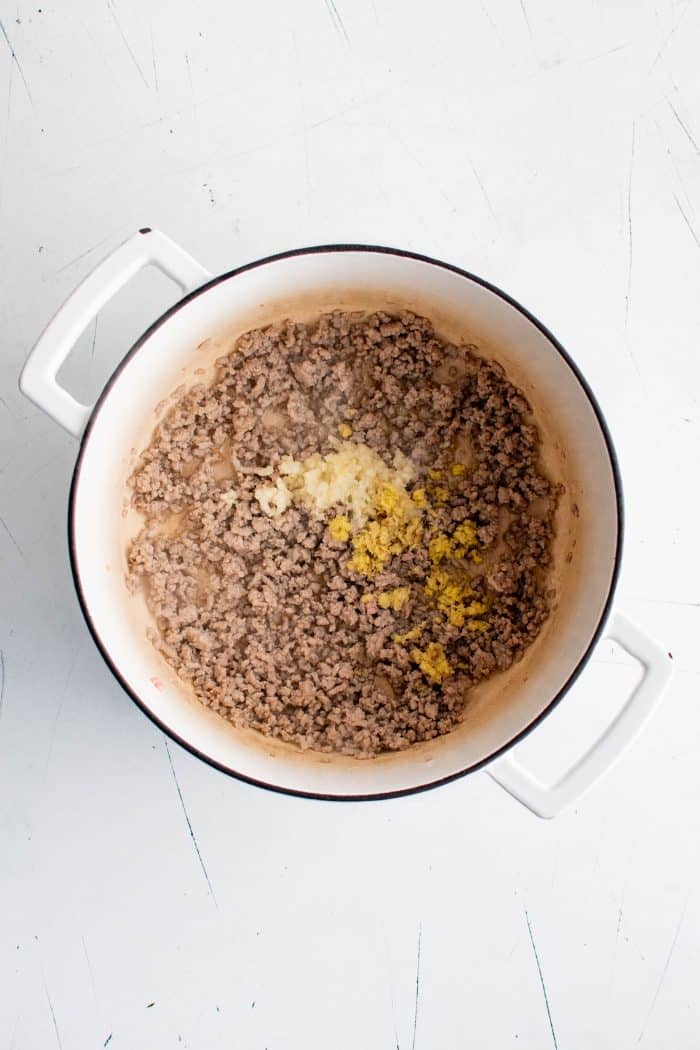
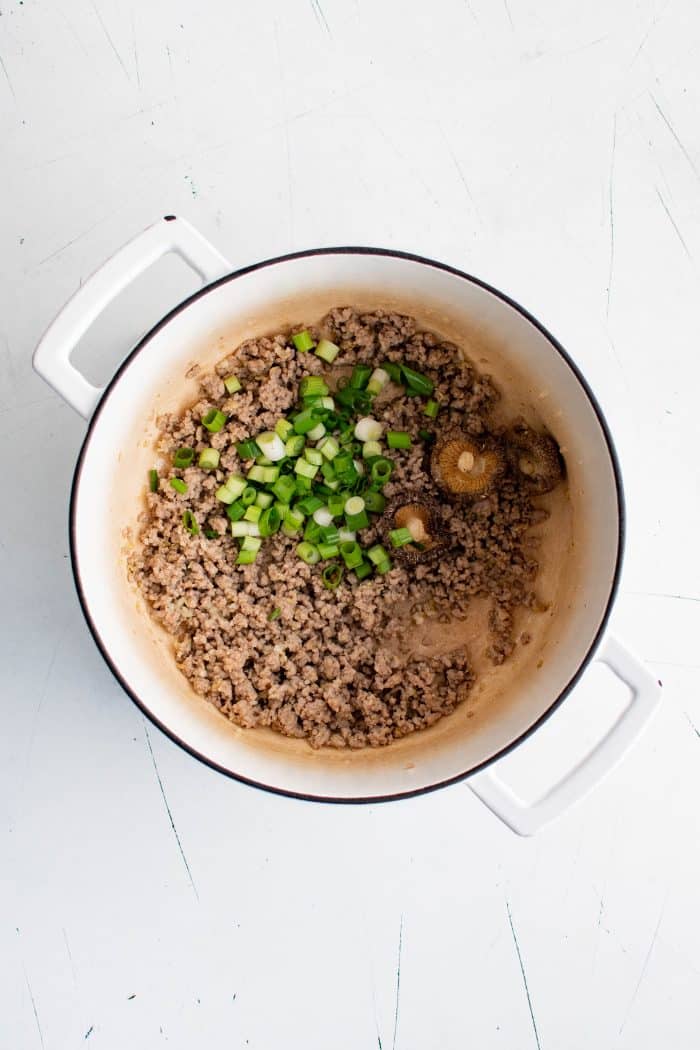
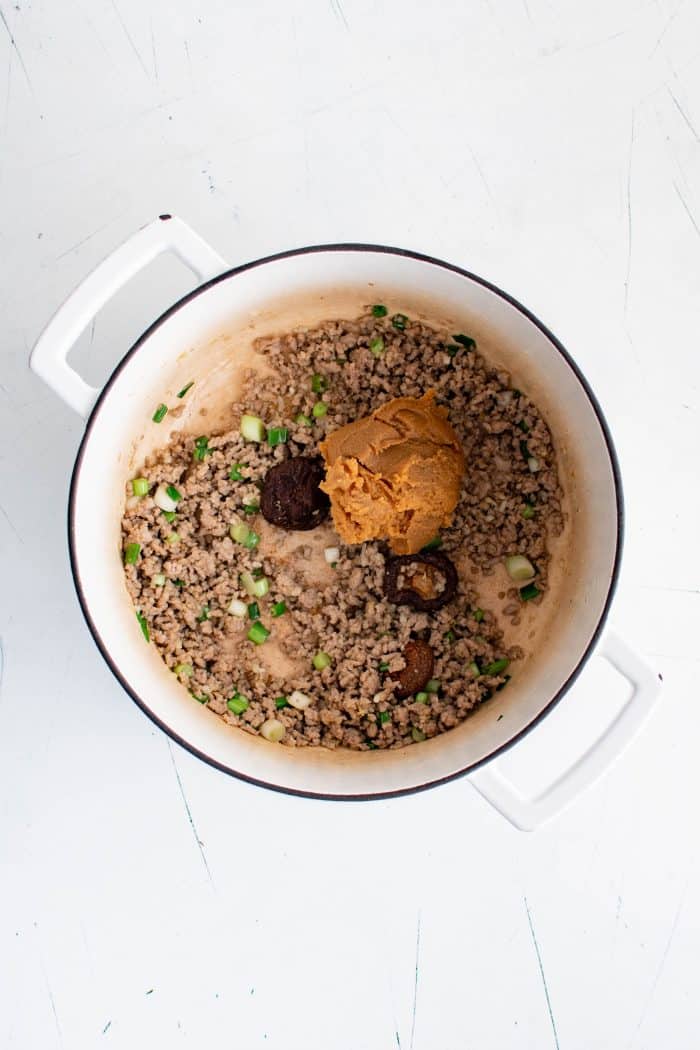
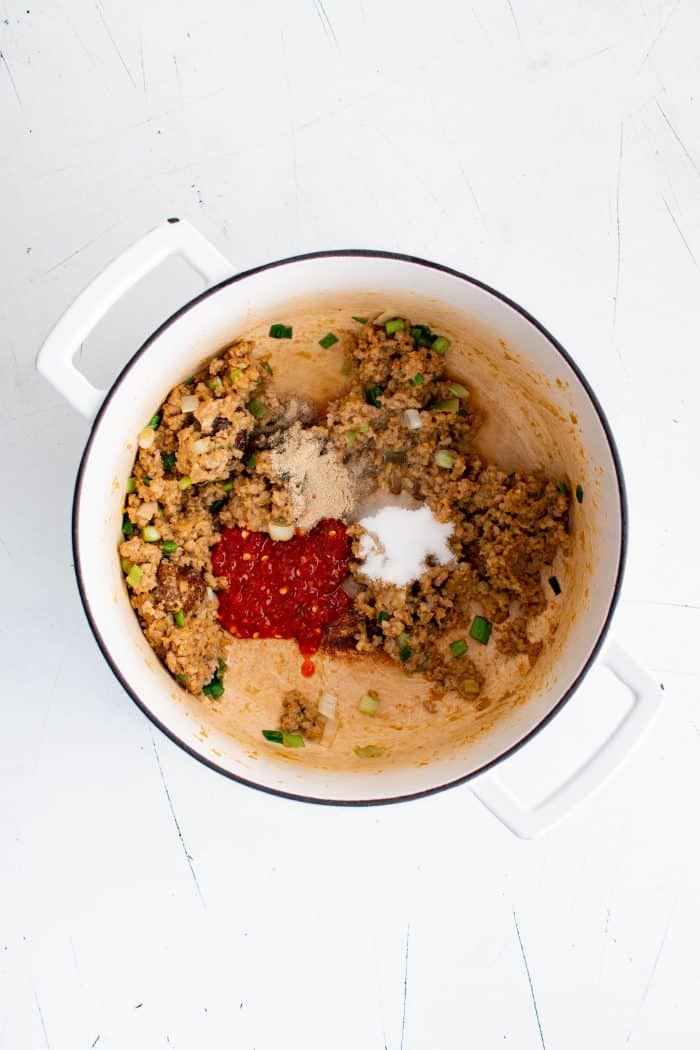
5. Stir in the liquid ingredients: Add the kombu broth, chicken broth, mirin, and sake. Bring to a boil, then reduce the heat to medium-low, cover slightly, and simmer for approximately 30 minutes.
6. Cook the ramen noodles: As the ramen broth simmers, bring a large pot of water to a boil and cook the ramen noodles according to package instructions – until al dente. Drain and toss with a tablespoon of sesame oil or vegetable oil so that they don’t stick together. Set aside.

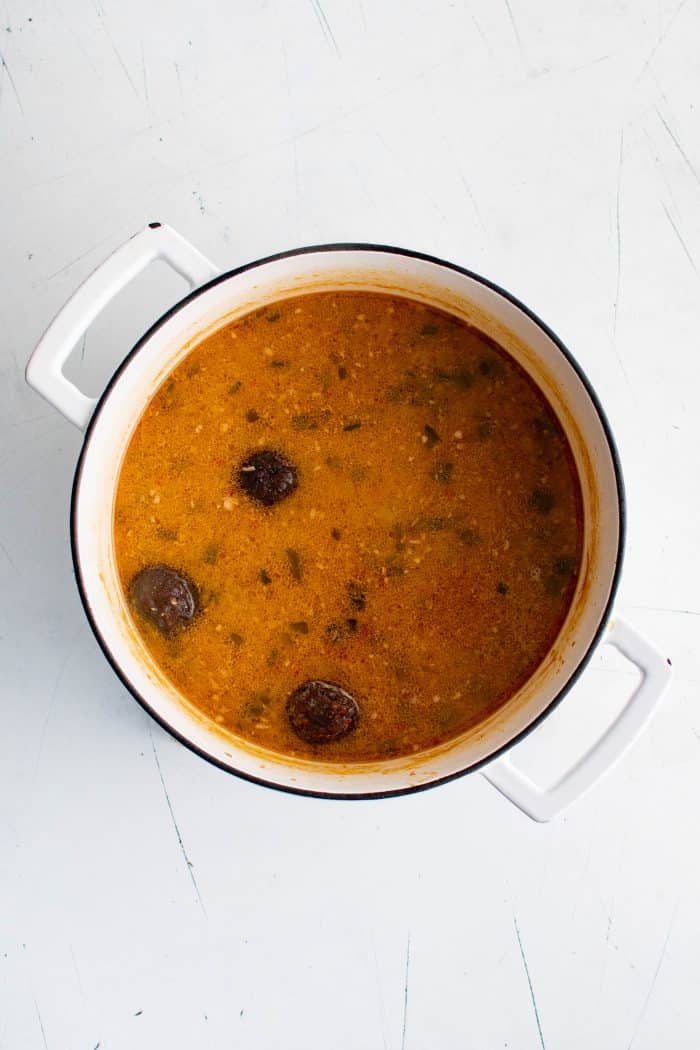
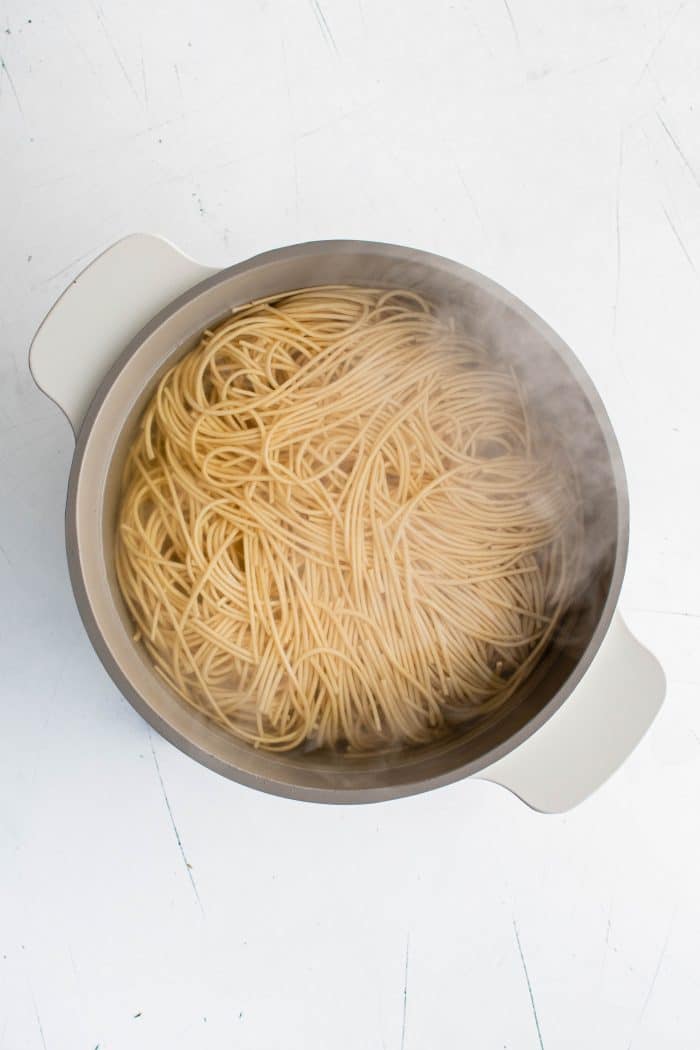
7. Prepare your ramen bowl: Divide the cooked ramen noodles between 4 serving bowls, and ladle the hot broth over the top. Serve with sliced green onions, sweet corn, soft-boiled eggs, seaweed squares, and chashu pork, if desired.
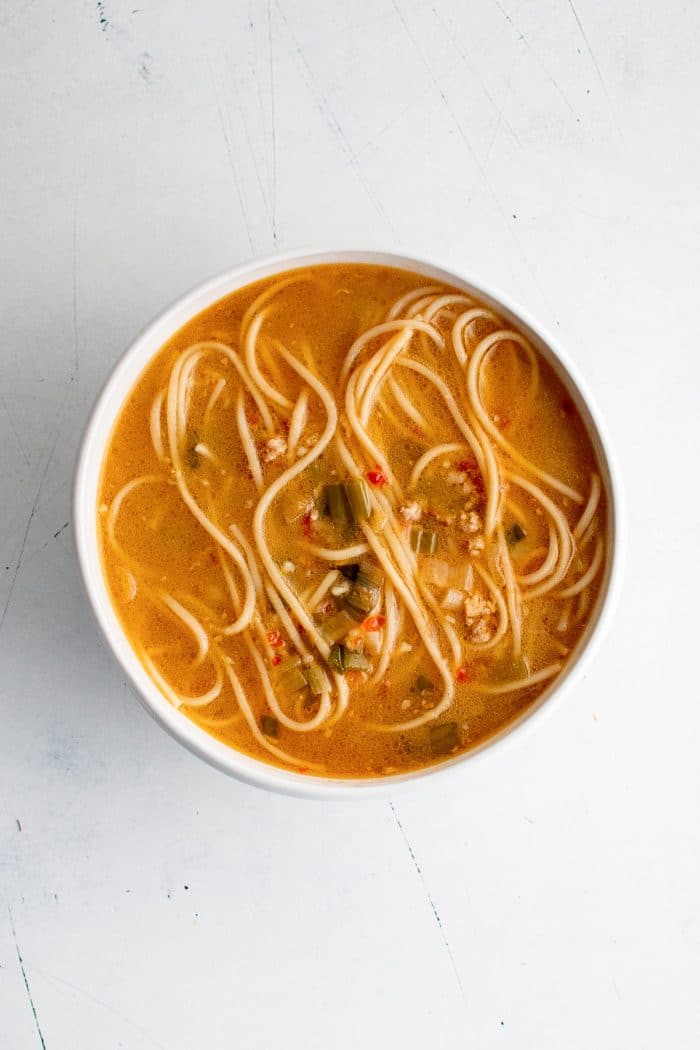
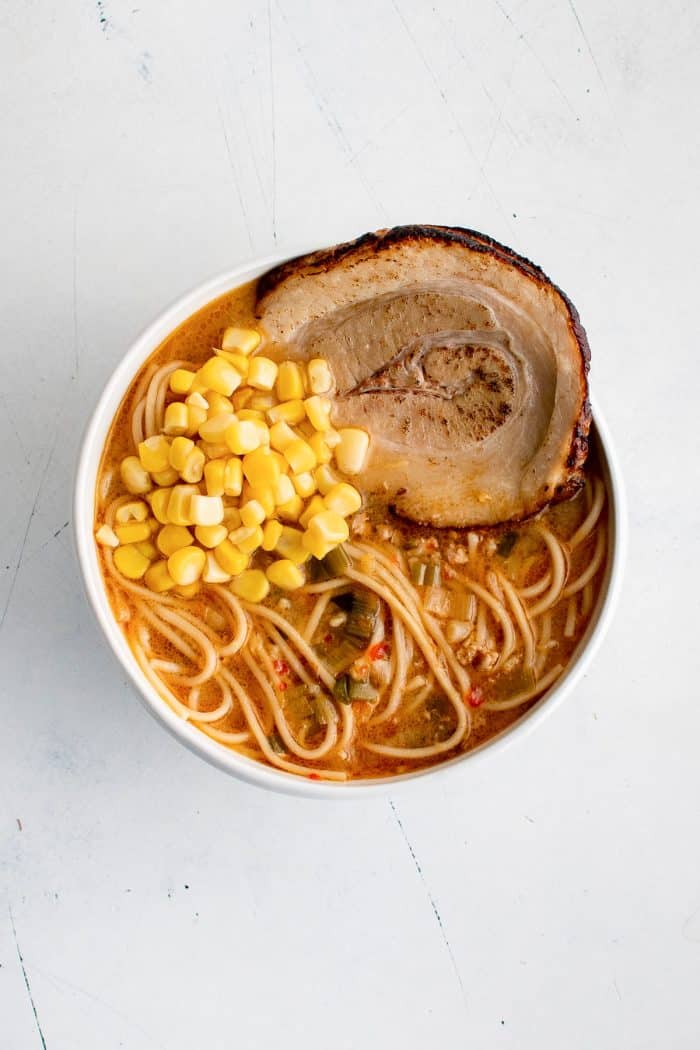
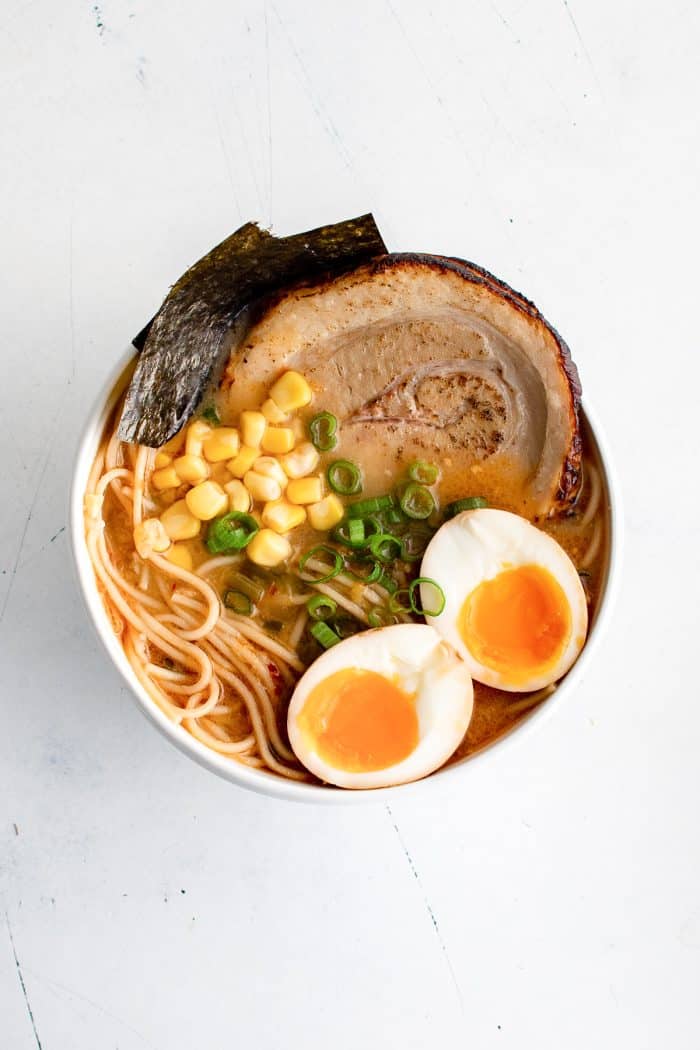
Miso Ramen Toppings
- Chashu: Thinly sliced, braised pork belly or pork loin. It’s tender, flavorful, and a very common topping for all types of ramen.
- Ajitsuke Tamago: These are soft-boiled eggs that have been marinated in a mixture of soy sauce, mirin, and other ingredients. The result is a flavorful egg with a still-runny yolk.
- Green Onions: Sliced green onions or scallions are a common garnish for ramen.
- Nori: This dried seaweed sheet is often tucked into the side of the bowl.
- Menma: These are fermented bamboo shoots, and they provide a nice crunchy texture.
- Bean Sprouts: These give a fresh and crispy texture to the ramen.
- Corn: Sweet corn is a common topping for miso ramen, especially in Sapporo, the largest city on the northern Japanese island of Hokkaido.
- Butter: A pat of butter melting into the hot soup is another topping often seen in Sapporo-style miso ramen.
- Ground Meat: Some versions of miso ramen (like this one!) also include ground pork or chicken.
- Seaweed: Different from Nori, wakame or other types of seaweed may be used.
- Mushrooms: Various types of mushrooms can be used for added texture and flavor.
- Spicy Bean Paste or Chili Oil: For those who like their ramen spicy.
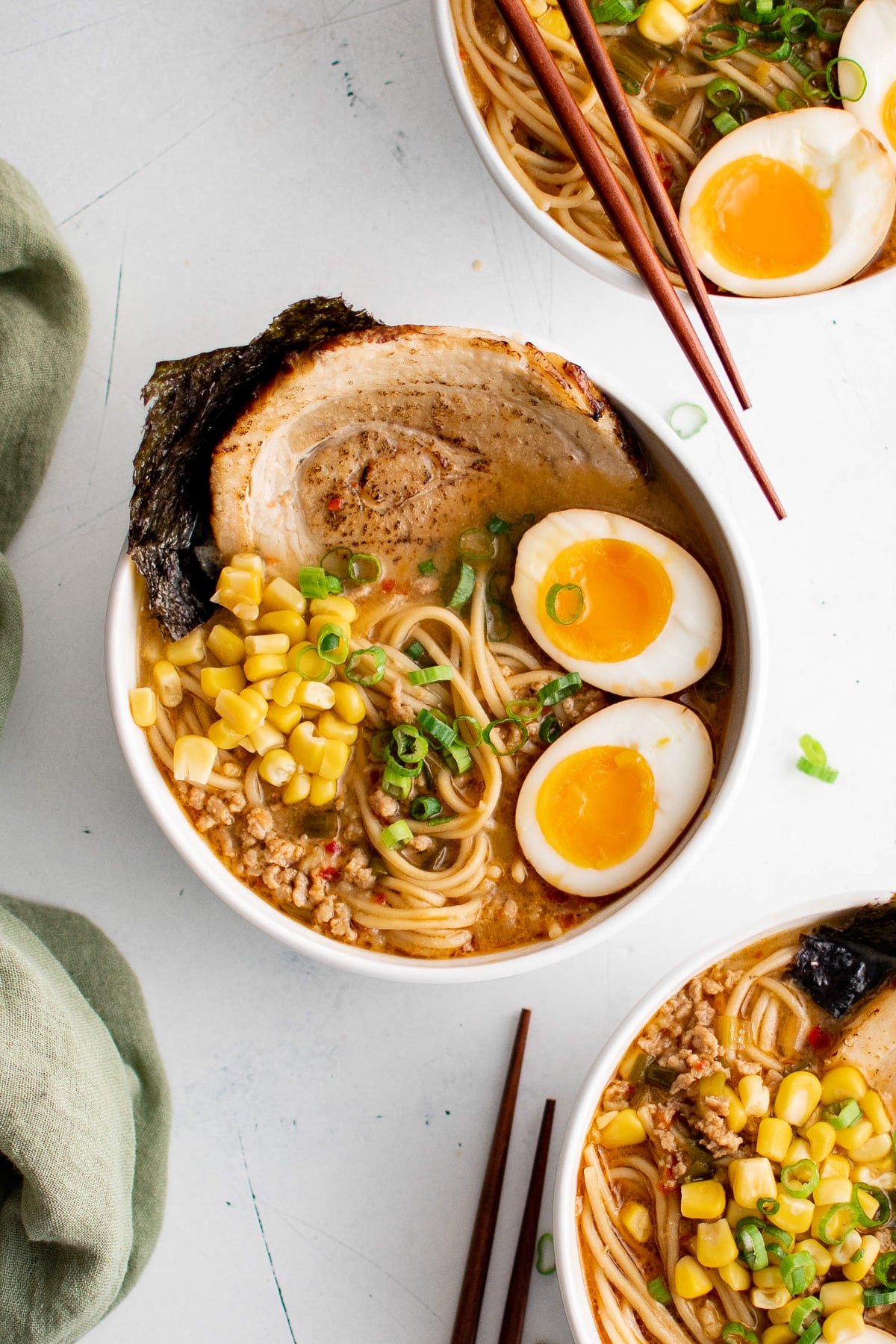
More Asian-Inspired Recipes:
- Easy Edamame Recipe
- Asian Garlic Noodles
- Beef and Broccoli Recipe
- Kung Pao Chicken
- Mongolian Beef
- 10-Minute Garlic Bok Choy Recipe
- Moo Goo Gai Pan Recipe
- Easy Teriyaki Chicken Recipe
If you try making this Miso Ramen Recipe, please leave me a comment and let me know! I always love to hear your thoughts.


Miso Ramen Recipe
Ingredients
- 1 piece kombu
- 2 teaspoon sesame oil
- ½ pound ground pork
- 3 cloves garlic, minced
- 1 thumb of ginger, peeled and minced
- 5 green onions, white and green parts sliced
- 4 dried shiitake mushrooms
- ½ cup miso paste, white or red miso paste
- 2 teaspoon doubanjiang (spicy bean paste), or chili garlic paste (gochujang)
- 1 tablespoon sugar
- 1 teaspoon white pepper
- 6 cups low-sodium chicken broth
- 1 tablespoon mirin
- 1 tablespoon sake
- 16 ounces ramen noodles, dried or fresh
- Optional toppings: Sweet corn, green onions, ramen eggs, seaweed squares, and Chashu.
Instructions
- In a small saucepan, boil 2 cups of water. Remove from heat and add the kombu. Allow it to sit for at least 10 minutes or up to an hour, then discard the kombu.
- In a separate large pot, heat the sesame oil over medium heat. Add the ground pork and cook until browned – about 5-7 minutes.
- Add the garlic and ginger and cook for 30 seconds until fragrant.
- Mix in the green onions and shiitake mushrooms and cook for 2 minutes.
- Add the miso paste, spicy bean paste, sugar, and white pepper, and cook for an additional minute.
- Pour in the kombu broth, chicken broth, mirin, and sake, bringing it to a boil. Once boiling, reduce the heat to medium-low and let it simmer for 30 minutes.
- While the broth is simmering, boil a large pot of water and cook the ramen noodles to al dente. Drain and toss with some sesame or vegetable oil so that they don’t stick and set aside.
- Divide the cooked ramen noodles between 4 bowls, and pour the hot broth over the top.
- Top with sliced green onions, sweet corn, ramen eggs, seaweed squares, and Chashu, if desired.
Notes
Nutrition
Nutrition information is automatically calculated, so should only be used as an approximation.
